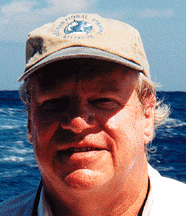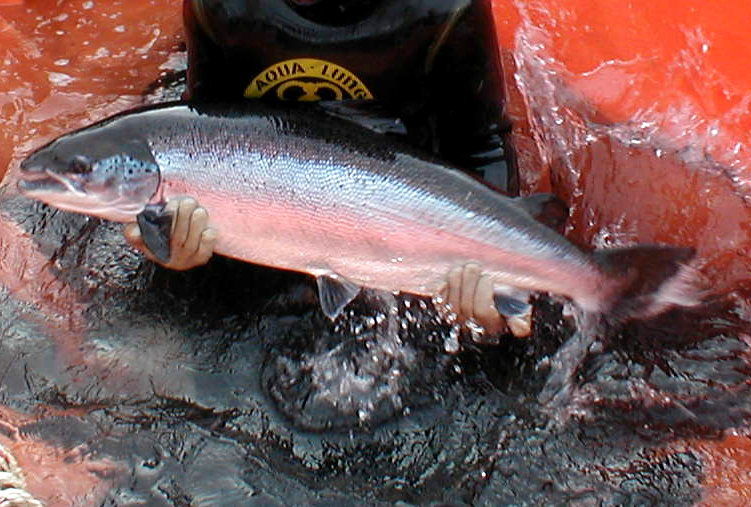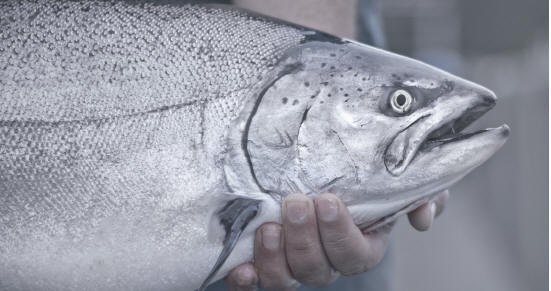"Farm-Raised" Salmon
|
"Farmed and Dangerous" As described below, we promote one brand of farm-raised Atlantic salmon, HiddenFjord premium salmon which is raised in the Faroe Islands (between Scotland and Iceland) and one brand of king salmon, Ora King Salmon which is raised in New Zealand. But most "farmed" salmon can be dangerous to one's health. Just one meal a month can pose a high cancer risk. Farmed or "pen-reared" salmon (usually marketed as Atlantic salmon but sometimes as Canadian king salmon) has generated front page news in the Washington Post because it can contain cancer-causing contaminants (PCBs and dioxins) in dangerous amounts. These are present in levels sufficient to pose an "unacceptable cancer risk" from eating only one 8 oz. portion per month, according to a peer reviewed study by Dr. David O. Carpenter and his team of scientists as published in "Science" (1/9/04) the Journal of the American Association for the Advancement of Science (AAAS). The source of the contaminants is in the feed given to most "farmed" salmon in their net pens. European farmed salmon had the highest levels, those from South America had the lowest and those from major U.S. markets, including Washington, D.C., had moderately high levels. For more specific information on the dangers of eating "farmed" salmon (also marketed as "organic" salmon) and its multiple problems (including escapees, disease and parasite transmission to wild populations, and habitat degradation), click here. Farmed salmon also has to be artificially colored (otherwise it would be gray). In contrast, wild salmon tastes superb and is the best source of protein one can find. Wild salmon spend their whole adult lives in the pristine waters of the North Pacific. Here they feed on natural prey including shrimp and krill (which look like small pink shrimp) and whose pink color is derived from eating algae containing carotenes (canthaxanthin and astaxanthin). When eaten by the wild salmon their pigments are incorporated into the salmon's flesh giving it its distinctive coloration. Sockeye salmon eat higher percentages of shrimp and krill and so are darker red than king and coho salmon whose diet includes large amounts of fish and squid. Wild fish need no artificial coloring. They are the epitome of perfection in terms of appearance, nutritional value and flavor. In contrast to farm raised salmon, eating a diet centered around wild salmon and the other Alaskan seafood we provide can reduce your risk of heart disease by 75% and extend your life expectancy by years. For details, see our Health Benefits link below. Many suppliers are apparently misrepresenting farm-raised salmon as wild. The New York Times reported on April 10, 2005, that only one of eight stores in New York was actually selling wild salmon according to scientific testing of the products' pigment levels (farm-raised salmon needs to be fed dyes to color them pink). For the story, go here. Most restaurants in the Washington area, including many of the most recognizable, routinely serve farm-raised salmon because it is cheap. Ask the server if their salmon is farm-raised. If customers were to inform the chef that they eat only wild salmon and don't order farm-raised salmon because of its cancer risk, this practice might end soon. The same can be said for seafood market managers. ( I have yet to find a seafood market not selling farmed salmon.) Use your consumer power to become an active force for change (also see What Seafood Should Not be Served?). Let them know you don't buy or eat farm-raised salmon because it is usually dangerous. Farm-Raised Salmon We Do Support
Faroe Island Atlantic Salmon
Since November 2011, we have been buying fresh, pen-reared Atlantic
salmon produced by Luna in the Faroe Islands (located in the middle of the North
Atlantic Ocean between Scotland and Iceland) because we know that their
aquaculture operations are well-managed and eliminate the normally
unsavory characteristics of most "farm-raised" salmon operations. We have
always been very willing to buy from and thus support aquaculture operations
that we know to be well run (such as for cobia off the Dominican
Republic/Puerto Rico, rainbow trout in North Carolina and sturgeon in the
Sacramento R) because it takes pressure off the wild stocks.
Specifically, our salmon are produced by Luna and the product is branded
as HiddenFjord premium salmon. Its story can be found at Luna's
website.
HiddenFjord premium salmon is the finest quality in the world. The care with
which HiddenFjord salmon are raised and packed is second to none.
As described here (http://salmon-from-the-faroe-islands.com/environment.html),
Faroe Island operations are required by law to follow strict best
management practices (including no use of antibiotics) and are located in
fjords swept by high volumes of very clean ocean water (particularly a branch
of the Gulf
Stream) thus minimizing any
on-site degradation. Most importantly, the feed used in the Faroe Islands
operations comes from sources proven by regular chemical monitoring to be free of contaminant burdens, which
is the main problem with most "farmed" salmon operations that use meal ground
from fish which themselves contain dangerous levels of PCBs, PAHs and other
cancer-causing chemicals (derived from burning of oil, coal and gasoline which
falls back to earth with rain and enters rivers and estuaries where they are
caught). Chemical monitoring of HiddenFjors salmon conducted since 2001
by the Faroese Food and Veterinary Agency has shown that all salmon samples
have been well within EU regulatory limits. The company (Lewis Mills & Co.)
that imports the salmon we buy states: "Our records indicate that seafood
products sold to our Customers are free of non-permitted aquaculture drugs and
or chemicals or environmental contaminants." The Faroe Island salmon operation
also uses very small amounts of feed - 1.11 lbs of feed for each pound of
salmon produced. Salmon farming operations typically require 4 lbs per
one pound of salmon produced thus exerting much greater pressure on wild
stocks as a source of their feed.
New Zealand "Ora King Salmon" Since last year we have also been buying and distributing premium quality King Salmon raised responsibly in New Zealand's South Island by the NZ King Salmon Co. This special brand is known as "Ora King Salmon" and its story is described on the company's website : www.orakingsalmon.co.nz
Their feed is of the greatest importance to us and the company sources its feed from both Australian and Chilean suppliers. All feeds are fully traceable and consist of the highest quality, sustainably-sourced raw materials designed for optimum health and nutrition. The company certifies, and as confirmed by its suppliers, that the feed consists of no antibiotics, vaccines, steroids, growth hormones and no unnatural substance or chemicals. The critically important ingredients consist of fish meal and fish oil from South American oceanic species (jack mackerel, anchovy and sardines) which themselves are free of dangerous contaminants. And through a greater use of land-based proteins and oils (from chickens as well as soybean products) the company is now able to produce more salmon protein than the fish protein and oils used in its production, thus it is not contributing to the depletion of wild fish stocks so typical of most salmon farming operations (described above). And since there are no salmon species endemic to the South Pacific, potential escapees pose no risk for wild populations. |
Additional Pages
Health Benefits of our Wild Products
Why Buy From Us? - 10 Good Reasons
What Seafood Should Not be Served?

Jim Chambers, Owner
Joe Boncore, Director of Operations (240-483-8475)
Prime Seafood, LLC, 9814 Kensington Parkway, Kensington, MD 20895
(Office) 301-949-7778 (Mobile) 202-330-9121
Updated 10/17/12

